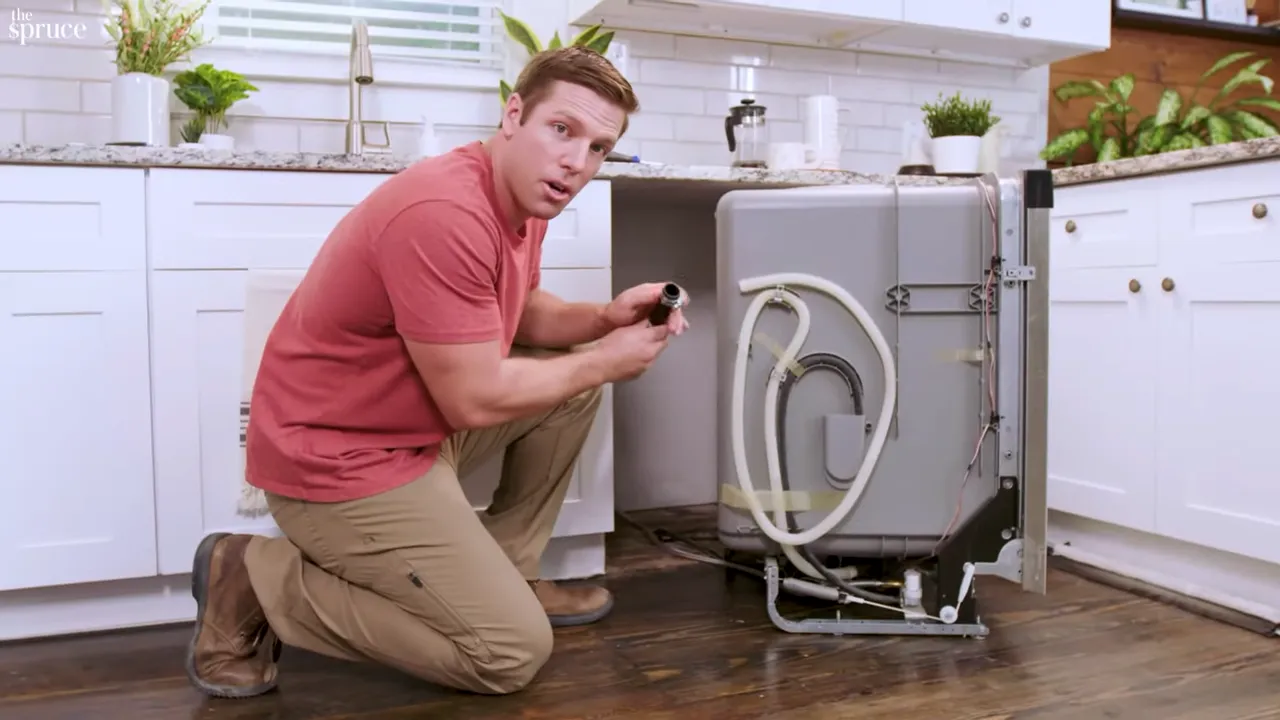To install a dishwasher drain hose to a garbage disposal, connect the hose to the disposal’s dishwasher inlet, securing it with a clamp or hose clamp. Then, connect the other end of the hose to the dishwasher drain pump, ensuring a tight fit to prevent leaks.
Integrating a dishwasher drain hose to a garbage disposal is a crucial step in ensuring effective and efficient drainage from your dishwasher. By properly connecting the hose to the garbage disposal, you can prevent water and waste from backing up into your dishwasher, avoiding potential damage and foul odors.
In this guide, we will walk you through the process of installing a dishwasher drain hose to a garbage disposal, ensuring a seamless and functional connection. Read on to learn the steps involved in this straightforward installation process.
Understanding The Dishwasher Drain Hose
One crucial component of a dishwasher that often goes unnoticed is the drain hose. The dishwasher drain hose performs the important function of carrying wastewater away from the dishwasher and into a proper disposal system. Understanding this integral part of your dishwasher is essential for a smooth and efficient installation process.
What is a dishwasher drain hose?
A dishwasher drain hose is a flexible pipe that connects the dishwasher unit to the garbage disposal or another drainage system. It is responsible for transporting the wastewater from the dishwasher to the appropriate location for disposal. Typically made of durable materials such as rubber or plastic, the drain hose ensures a secure and leak-free connection between the dishwasher and the disposal system.
Importance of a properly installed drain hose
Installing the dishwasher drain hose correctly is crucial for the efficient operation of your dishwasher. A properly installed drain hose ensures that wastewater flows smoothly from the dishwasher to the disposal system, preventing clogs and backups that can lead to water damage and costly repairs. Additionally, a secure connection between the drain hose and the disposal system prevents leaks, further protecting your kitchen and its surrounding areas from potential water damage.
Materials needed for installation
Before beginning the installation process, gather the following materials:
| Materials |
|---|
| Dishwasher drain hose |
| Hose clamp |
| Pipe wrench or pliers |
| Screwdriver |
| Teflon tape |
Having these materials on hand will ensure a smooth and efficient installation process and allow you to connect your dishwasher to the disposal system quickly and securely.
By understanding the role of the dishwasher drain hose and ensuring its proper installation, you can enjoy the convenience of a functional and leak-free dishwasher while avoiding potential water damage and costly repairs. The next step is to follow the specific installation instructions provided by your dishwasher manufacturer for a successful and hassle-free connection process.
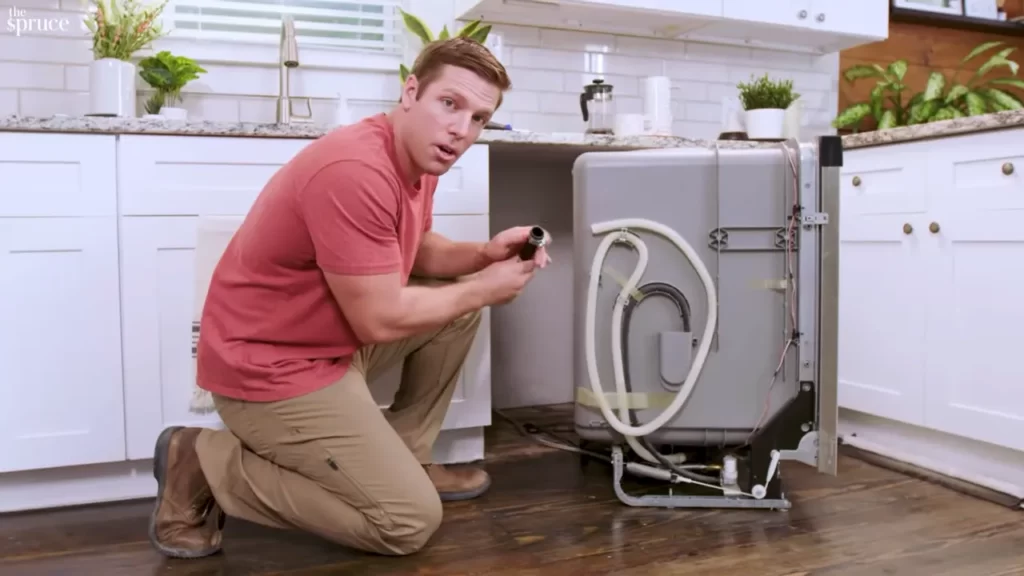
Preparing The Garbage Disposal
Before you can install a dishwasher drain hose to a garbage disposal, it is essential to properly prepare the garbage disposal unit. This involves inspecting the unit, clearing any existing blockages, disabling the power supply, and removing the garbage disposal knockout plug. Here’s a step-by-step guide on how to carry out each of these tasks:
Inspecting the garbage disposal unit
The first step in preparing the garbage disposal is to thoroughly inspect the unit. Look for any signs of damage or wear and tear, such as leaks, rust, or cracks. Pay close attention to the connection areas where the dishwasher drain hose will be attached. Ensure that all the components are in good condition and that there are no loose or broken parts.
Clearing any existing blockages
Next, check for any existing blockages in the garbage disposal unit. Over time, food particles, grease, and other debris can accumulate and cause clogs. This can hinder the proper flow of water and potentially lead to drainage issues. Use a flashlight to inspect the inside of the disposal, looking for any obstructions. If you notice any blockages, use a long-handled tool or a plumber’s snake to dislodge and remove them.
Disabling power supply
Working with a live electrical connection can be dangerous, so it is crucial to disable the power supply to the garbage disposal unit before proceeding further. Locate the circuit breaker or fuse that controls the power to the disposal and switch it off. For added safety, use a voltage tester to confirm that there is no electricity running to the unit. Once you are certain the power is disabled, you can proceed with the installation process.
Removing the garbage disposal knockout plug
Finally, you need to remove the garbage disposal knockout plug to allow for proper drainage from the dishwasher. This plug is a small plastic piece that blocks the dishwasher drain connection on the disposal unit. Without removing it, the dishwasher will not be able to drain into the disposal. Check the user manual or manufacturer’s instructions for your specific garbage disposal model to locate the knockout plug. Use pliers or a screwdriver to carefully remove the plug, ensuring it is completely taken out.
By following these steps to prepare the garbage disposal unit, you will be ready to install the dishwasher drain hose and ensure effective and efficient drainage from your dishwasher to the garbage disposal.
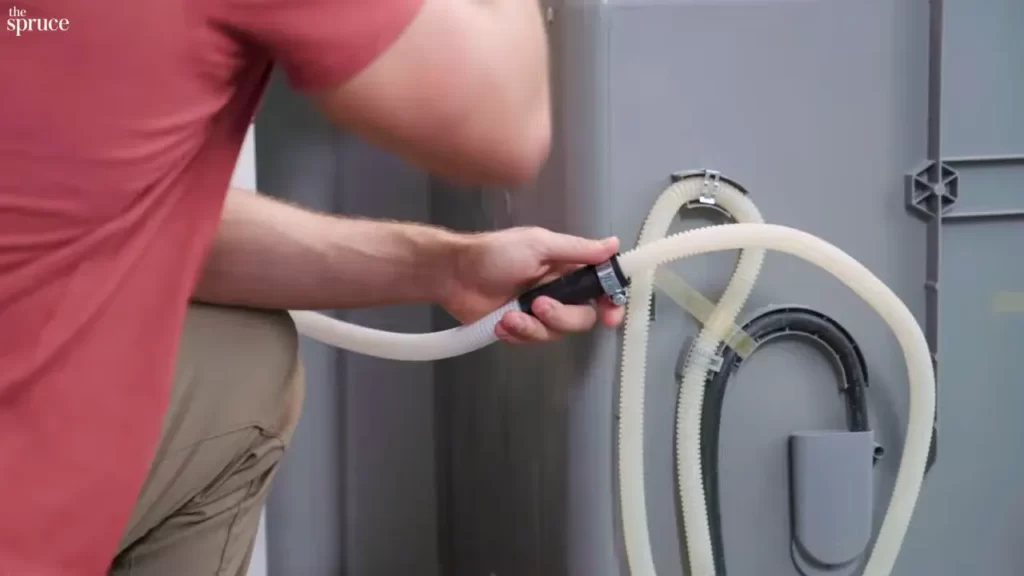
Proper Routing Of The Dishwasher Drain Hose
Installing a dishwasher drain hose to a garbage disposal is an essential step to ensure a proper drainage system in your kitchen. The correct routing of the dishwasher drain hose plays a crucial role in preventing clogs, backups, and potential damage. In this section, we will guide you through the steps involved in determining the drain hose path, ensuring a high loop configuration, connecting the drain hose to the dishwasher, and securing it with clamps or zip ties.
Determining the drain hose path
Before starting the installation process, it is important to determine the proper path for the dishwasher drain hose. Ideally, the drain hose should be routed through the kitchen cabinet in the shortest and most direct path to reach the garbage disposal or sink drain. Make sure to account for any obstacles that may be present, such as wiring or plumbing pipes.
Ensuring a high loop configuration
One of the crucial steps in properly installing the dishwasher drain hose is to ensure a high loop configuration. This helps prevent dirty water from the sink or garbage disposal flowing back into the dishwasher, which can lead to unpleasant odors and contamination. To create a high loop, attach the drain hose to the underside of the countertop or to the side of the cabinet, ensuring that it reaches a point higher than the sink drain or garbage disposal inlet.
Connecting the drain hose to the dishwasher
With the drain hose path determined and the high loop configuration in place, it’s time to connect the drain hose to the dishwasher. Locate the drain hose outlet on the dishwasher and firmly attach one end of the drain hose to it. Use a hose clamp to secure the connection and ensure a tight fit.
Securing the drain hose with clamps or zip ties
Lastly, to ensure the drain hose remains in place and does not become loose over time, it’s important to secure it with clamps or zip ties. These fasteners will prevent the hose from shifting, which could lead to leaks or disconnection. Place clamps or zip ties at regular intervals along the drain hose, making sure they are tight enough to keep the hose secure but not too tight to cause damage.
In Conclusion
The proper routing of the dishwasher drain hose is a key step in the installation process. By following the steps of determining the drain hose path, ensuring a high loop configuration, connecting the drain hose to the dishwasher, and securing it with clamps or zip ties, you can ensure a reliable and efficient drainage system for your dishwasher. Remember, proper installation helps prevent clogs and potential damage, ensuring that your kitchen remains clean and functional.
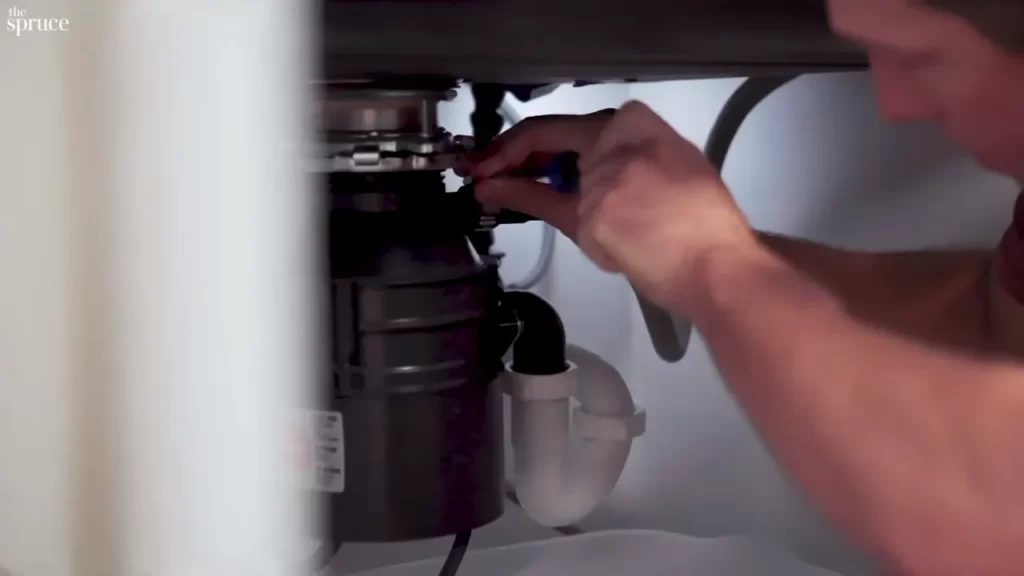
Connecting The Dishwasher Drain Hose To The Garbage Disposal
When it comes to installing a dishwasher drain hose to a garbage disposal, it is essential to properly connect the two to ensure efficient and effective wastewater disposal. One of the crucial steps in this process is connecting the dishwasher drain hose to the garbage disposal unit. By understanding the dishwasher drain connection on the disposal unit, properly aligning the drain hose with the disposal port, and securing the drain hose to the disposal unit with a clamp, you can ensure a seamless connection that will prevent any potential leaks or drainage issues.
Understanding the dishwasher drain connection on the disposal unit
Before you begin the installation process, it is important to familiarize yourself with the dishwasher drain connection on the garbage disposal unit. This connection is usually located on the side or the back of the disposal and is specifically designed to accommodate the dishwasher drain hose. It typically consists of a small port with a threaded fitting to which the drain hose will be connected.
Properly aligning the drain hose with the disposal port
Once you have located the dishwasher drain connection on the garbage disposal unit, the next step is to align the drain hose with the disposal port. To do this, ensure that the end of the drain hose is cut straight and free from any obstructions. Then, gently push the end of the drain hose onto the disposal port until it fits tightly and securely. Be careful not to force the hose or damage the threads on the disposal port.
Securing the drain hose to the disposal unit with a clamp
Once the drain hose is properly aligned with the disposal port, it is important to secure it in place to prevent any potential leaks. This can be done by using a hose clamp, which is a metal band that can be tightened around the drain hose and disposal port. Place the clamp around the hose and port, making sure it is positioned at least 1 inch from the end of the hose. Then, use a screwdriver to tighten the clamp until it is snug and secure. Ensure that the clamp is not too tight to avoid damaging the drain hose or the disposal unit.
By following these simple steps, you can easily connect the dishwasher drain hose to the garbage disposal, ensuring proper drainage and preventing any potential leaks or clogs. Remember to test the connection by running water through the dishwasher and disposal to ensure everything is functioning correctly.
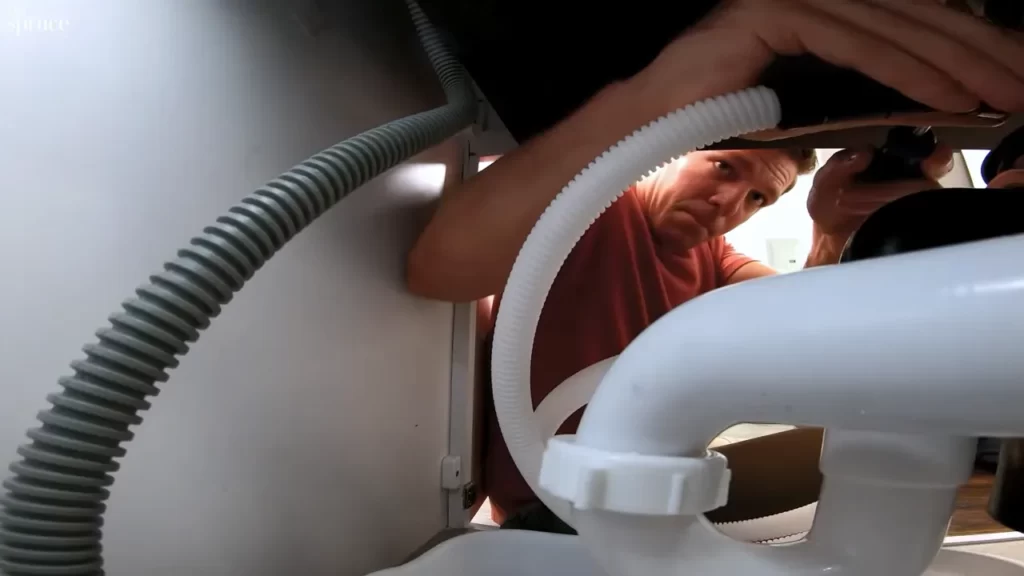
Testing And Troubleshooting
Testing for leaks and proper drainage
Now that you have successfully installed the dishwasher drain hose to the garbage disposal, it’s crucial to test for any leaks or issues with drainage. Testing the system will ensure that everything is working properly before you move on. Here are the steps to effectively test for leaks and proper drainage:
- Run a test cycle: Start by running a test cycle on your dishwasher. Make sure to follow the manufacturer’s instructions for running a test cycle.
- Check for leaks: While the dishwasher is running, closely inspect the connections between the drain hose and the garbage disposal. Look for any signs of water leakage or dripping. If you notice any leaks, tighten the connections or replace any faulty parts.
- Verify proper drainage: Once the test cycle is complete, open the dishwasher and check for any standing water or residue. Proper drainage is essential to ensure that your dishwasher functions optimally. If you notice any issues with drainage, continue troubleshooting using the steps below.
Common issues and troubleshooting tips
Sometimes, even with proper installation, issues can arise. Here are some common issues you may encounter when installing a dishwasher drain hose to a garbage disposal, along with troubleshooting tips to resolve them:
- Slow drainage: If you notice that the water is draining slowly or not draining at all, it may be due to a clog in either the drain hose or the garbage disposal. Try running a drain cleaner through the system to remove any blockages. Additionally, check for any kinks or bends in the drain hose that may be restricting proper flow.
- Odors or foul smells: A foul smell emanating from the dishwasher or garbage disposal can be a sign of a drainage issue. To eliminate odors, try running a mixture of vinegar and baking soda through the dishwasher. This will help break down any buildup or debris that may be causing the odor.
- Noise or vibration: Excessive noise or vibration during the dishwasher cycle can be a result of an improperly installed drain hose. Check that the hose is securely connected and not rubbing against any other components. Adjust the hose if necessary to reduce noise and vibration.
Revisiting the installation if problems persist
If you have followed the troubleshooting tips above and are still experiencing issues with your dishwasher drain hose installation, it may be necessary to revisit the installation process. Here are the steps to ensure a thorough inspection and resolution of the problem:
- Disconnect the drain hose: Start by disconnecting the drain hose from both the dishwasher and the garbage disposal.
- Inspect the hose: Carefully examine the drain hose for any signs of damage or blockages. If required, clean the hose using a mild detergent and warm water.
- Check connections: Once the drain hose is clean, reattach it to both the dishwasher and the garbage disposal. Double-check all connections to ensure they are secure.
- Retest the system: Run another test cycle on your dishwasher to verify that the issues have been resolved. Pay close attention to any potential leaks or drainage problems.
By following these testing and troubleshooting steps, you can ensure that your dishwasher drain hose is properly installed and functions without any issues. If problems persist, it may be necessary to seek professional assistance to resolve the problem effectively. Remember, regular maintenance and inspection can help prevent future issues and keep your dishwasher running smoothly.
Maintenance And Care Tips
Regularly cleaning the dishwasher drain hose and disposal unit
To ensure proper functioning of your dishwasher and garbage disposal, it is essential to regularly clean the dishwasher drain hose and disposal unit. Over time, these components can become clogged with food debris, soap scum, and other residues, leading to unpleasant odors and poor drainage. Follow these simple steps to clean them efficiently:
- Start by disconnecting the power supply to both the dishwasher and the garbage disposal unit.
- Gently remove the dishwasher drain hose from the garbage disposal. Take care not to damage the hose or any other connecting parts.
- Using a detergent solution or a mixture of white vinegar and water, thoroughly clean the dishwasher drain hose. You can use a long flexible brush or pipe cleaner to reach any hard-to-reach areas.
- Similarly, clean the garbage disposal unit using the same cleaning solution. Make sure to remove any food particles or debris that may have accumulated inside.
- Once everything is clean, reconnect the dishwasher drain hose to the garbage disposal unit and secure it tightly to avoid any leaks.
- Finally, restore the power supply to both the dishwasher and the garbage disposal unit.
Checking for blockages and debris buildup
Regularly checking for blockages and debris buildup is crucial to maintain the smooth operation of your dishwasher drain hose and garbage disposal unit. Here are some key steps to follow:
- Inspect the dishwasher drain hose for any kinks, bends, or clogs. If you notice any blockages, remove them using a plumber’s snake or a wire coat hanger with a bent tip.
- Examine the garbage disposal unit for any visible debris. Use a flashlight to ensure you have a clear view of the inside. If you spot any clogs, carefully remove them with a pair of tongs or a long-handled spoon.
- Don’t forget to check the dishwasher filter for any trapped food particles. Cleaning or replacing the filter regularly will prevent clogs and ensure efficient drainage.
- After inspecting and cleaning, run a test cycle to verify that the dishwasher drain hose and garbage disposal unit are functioning correctly.
Proper disposal of food waste to prevent clogs
One of the most effective ways to prevent clogs in your dishwasher drain hose and garbage disposal unit is to dispose of food waste properly. Here are some tips to keep in mind:
- Avoid putting large food scraps or bones down the garbage disposal. Instead, scrape off excess food into the trash or compost bin before rinsing dishes.
- Run cold water while operating the garbage disposal to help flush away food particles.
- Never pour grease or oil down the drain, as it can solidify and cause blockages.
- Use a strainer or filter in the sink to catch any small food particles that may accidentally go down the drain.
- Regularly empty and clean the garbage disposal to prevent the buildup of odors and food residues.
By following these maintenance and care tips, you can ensure a healthy and efficient dishwasher drain hose and garbage disposal unit. Taking proactive steps to prevent clogs and keeping these components clean will help prolong their lifespan and save you from costly repairs in the long run.
Final Thoughts
Ensuring a proper connection between your dishwasher and garbage disposal is essential for maintaining a well-functioning dishwasher drain system. By following the installation steps and implementing a few maintenance tips, you can ensure that your dishwasher drains efficiently and prevents any potential clogs or leaks.
Importance of a well-functioning dishwasher drain system
A well-functioning dishwasher drain system is crucial for the proper operation of your dishwasher. Without a proper connection between the dishwasher drain hose and the garbage disposal, water can back up, leading to unpleasant odors and potential water damage. Additionally, a clogged or inefficient drain system can result in poor dishwashing performance, leaving your dishes dirty and requiring extra cycles to clean properly.
Quick recap of the installation steps
- Start by gathering the necessary tools and materials, including a dishwasher drain hose, a hose clamp, and a screwdriver.
- Turn off the power to your dishwasher by switching off the electrical circuit that supplies it.
- Disconnect the old drain hose from the dishwasher and the garbage disposal, making sure to drain any residual water into a bucket.
- Attach the new dishwasher drain hose to the dishwasher, securing it with a hose clamp.
- Connect the other end of the drain hose to the inlet on the garbage disposal unit, again using a hose clamp to ensure a tight fit.
- Tighten all connections and ensure there are no leaks.
- Turn the power back on, and run a test cycle to check for proper drainage and to verify that there are no leaks.
Tips for maintaining an efficient dishwasher drainage system
- Regularly inspect and clean the dishwasher drain filter to prevent debris from accumulating and causing clogs.
- Avoid overloading the dishwasher, as it can strain the drain system and lead to inefficient draining.
- Run hot water through the garbage disposal after each use to help break down any trapped food particles.
- Periodically check the dishwasher drain hose for any signs of wear or damage and replace if necessary.
- Consider using a dishwasher cleaner to remove any built-up residue and maintain the overall performance of your dishwasher.
Frequently Asked Questions
Does A Dishwasher Drain Hose Need A Loop?
Yes, a dishwasher drain hose needs a loop. The loop prevents backflow and ensures proper drainage.
How Do You Plug A Dishwasher Drain Into A Garbage Disposal?
To plug a dishwasher drain into a garbage disposal, locate the dishwasher drain hose. Remove the knockout plug from the disposal’s dishwasher inlet. Connect the hose to the inlet, using a clamp to secure it. Ensure there are no leaks and turn on the dishwasher to test the connection.
What Is The Proper Way To Install A Dishwasher Drain Hose?
To properly install a dishwasher drain hose, follow these steps: 1. Connect one end of the hose to the dishwasher’s drain outlet. 2. Securely attach the other end of the hose to a high point in the plumbing system. 3.
Ensure the hose is not kinked or twisted. 4. Use a hose clamp to secure the connections. 5. Test for leaks and make any necessary adjustments.
Where Do You Drill A Hole In A Dishwasher Drain Hose?
Drill a hole in the dishwasher drain hose at the highest point to prevent water from flowing back into the dishwasher. Make sure to choose the appropriate drill size for the hole for proper drainage.
Conclusion
Installing a dishwasher drain hose to a garbage disposal is a crucial step in ensuring efficient and effective kitchen functionality. By following the steps outlined in this blog post, you can easily connect the two components and prevent potential drainage issues.
Remember to double-check your connections and ensure that everything is secure before testing the dishwasher. With this knowledge, you can confidently tackle this installation and enjoy a fully functional dishwasher setup in your kitchen.
